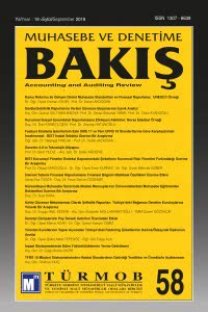ŞİRKET BİRLEŞMELERİNİN BİR PARÇASI OLARAK ELDE EDİLEN VE AKTİFLEŞTİRİLEN MADDİ OLMAYAN DURAN VARLIKLARIN DEĞERLEMESİ VE İNGİLTERE TECRÜBESİ
Maddi Olmayan Duran Varlıklar, Değerleme, Maliyet Yaklaşımı, Piyasa Yaklaşımı, Gelir Yaklaşımı
Intangible Assets, Valuation, Cost Approach, Market Approach, Income Approach,
___
- Abel, Mark. “Theme III: Methodologies for Determining the Value of Industrial Property Asssets-Viewpoint of an Institution for the Management of Industrial Property Rights”,WIPO National Seminar on the Valuation of Industrial Property Asset, Beijing, 1996
- Bertolotti, Nick. “Methodology for Determining the Value of Industrial Property Assets – Viewpoints of a Pro- fessional Consultant Engaged in Valuating Industrial Property Asset” WIPO National Seminar on the Valuati- on of Industrial Property Assets, Beijing, 1996
- Bonduelle, Yann; Valuing Intangible Assets- Impairment Tests, Pricewaterhouse Coopers, London 2003
- Bouteiller, Christophe. “The Evaluation of Intangible Asset: Advocating for an Option Based Approach”, 6. Al- tenative Perspective on Finance Conference, Hamburg, 2002 http://www.departments.bucknell.edu/manage- ment/apfa/Hamburg%20Papers/Bouteiller.pdf
- Coggin, Dana T. “Let’s Not Abandon the Cost Approach”, The Appraisal Journal, Vol. 62, Issue 1, 1994, p.144
- Diamond, Michael A.; Nicolaisen, Donald T. “Intangibles”, Handbook of International Accounting, Ed. by Frederic D.S. Choi, Newyork, John Wiley & Sons Inc., 1991
- Dotzour, Mark G; Freitag, Mark R, “The cost approach in residential appraising: Make it optional”, The Apprai- sal Journal, Vol.63, Issue 2, 1995, ss.182-186
- Egginton, Don A. “Toward Some Principle for Intangible Asset Acccounting”, Accounting and Bussiness Re- search , Vol: 20, No: 79, 1990
- FEI Reseach Foundation Issue Alert, Intangibles: What Their Valuation is Really Worth, 2002
- Gajland, David. “Valuation of Intellectual Property Assets: Significant, Parameters, Methodologies and Limita- tions, WIPO Asian Regional Seminar on the Promotion of the Use of the Intellectual Property System by the Private Sector, Daeduk, Republic of Korea, 1998
- Iwan, Gregory A. “The Cost Approach - Inflexible or Infeasible?”, The Appraisal Journal, Vol. 61, Issue 1, , p.136-137
- Kaplan, Robert S.; Norton David P. Strategy Maps, Boston, Harvard Business School Press, 2004
- King, Alfred M; Henry, Jay M. ?Valuing Intangible Assets Through Appraisals”, Strategic Finance, Vol.81, Iss. 5, Nov, 1999
- Lawrence, Steve. “The historical Development of Accounting Standards - Part5”, Professional Scheme, Lianyuan, Ma. “Valuation of Intellectual Property Assets; Valuation Techniques: Parameters, Methodologies and Limitations”, WIPO Asian Regional Forum on the Intellectual Property Strategy for the Promotion of In- novative and Inventive Activities, Beijing, 2000
- Lück, Gert. “Theme I: The Importance of Assessing the Value of Industrial Property Assets – Viewpoint of a Right Holder (Inventor, Enterprise or Institution)” WIPO National Seminar on the Valuation of Industrial Property Assets, Beijing 1996
- Marchitelli, Richard “Rethinking the Cost Approach”, The Appraisal Journal, Vol. 60, Issue 3, 1992, ss.424-426
- Muller, Karl A. “ An examination of the voluntary recognition of the acquired brand names in the United King- dom”, Journal of Accounting & Economics, No: 26, October 1999
- Mundy, Bill. “The Specific Methods and the Appraisal Process”, The Appraisal Journal, Vol. 60, Issue 3, 1992, s.493-499
- Oetzel, Terrell R. “Some Thoughts on the Cost Approach”, The Appraisal Journal, Vol. 61, Issue 1, 1993, ss.132
- Parr, Russell. “Module 6: IP Valuation Issues and Strategies”, Singapore-WIPO Joint Training Course for Asi- a and the Pacific Region on Intellectual Property and Technopreneurship Development, Singapore, 1999
- Price Waterhouse Coopers, Shedding Light on IFRS: IFRS 3 The new Business Combination Standard, 2002
- Reilly, Robert F.; Schweihs, Robert P. Valuing Intangible Assets, New York, McGraw-Hill, 1999
- Robinson, Rudy R; Lucas, Scott R. “Appraising Special-Purpose Industrial Facilities for Ad-Valorem Purposes”, The Appraisal Journal, Vol. 71, Issue 4, 2003, pp.323-324
- Santo, Jacquelyn Dal. “Intelectual Property Income Projections: Approaches and Methods”, The Handbo- ok of Business Valuation and Intellectual Property Valuation, Ed. Robert F Reilly, Robert P. Schweihs, New York, McGraw-Hill, 2004
- Schwartzben, Dov; Finkler, Steven A. “Combining Accounting Approaches to Practice Valuation”, Healthcare Financial Management, Vol. 52, Issue 6, 1998, ss.72-76
- Shortridge, Rebecca Toppe; Schroeder, Amanda; Wagoner, Erin. “Fair-Value Accounting- Analyzing the Chan- ging Environment” The CPA Journal Online, April 2006
- Smith, Gordon J.“Assesment and Valuation of Inventions and Research Results for Their Use and Commerciali- zation”, International Workshop on Management and Commercialization of Inventions and Technology, Monterrey, 2002
- Smith, Gordon V. Trade Valuation, New York, John Wiley & Sons Inc, 1996
- Smith, Gordon V. Parr L. Rusell: Valuation of Intellectual Property and Intangible Assets, New York, John Wiley & Sons Inc., Third Ed., 2000
- Sveiby, Erik. “Methods for Measuring Intangible Assets”, http://www.sveiby.com/articles/IntangibleMethods.htm, 2005
- Tollington, Tony. “UK Brand Asset recognition Beyond – Transaction or Events”, Long Range Planning, No: Issue 4, August 2001
- Wyett, John. “A guide to FRS 10 Goodwill and Intangible Assets”, Professional Scheme Yang, J. M. ?The Valuation of Intangibles”, The Accounting Review, Vol. 2, NO. 3, 1927, ss.224-228 www.ivsc.org www.tmsk.org.tr
- ISSN: 1307-6639
- Yayın Aralığı: 3
- Başlangıç: 2000
- Yayıncı: TÜRMOB
MUHASEBE MESLEK MENSUPLARININ MESLEKİ FAALİYETLERE İLİŞKİN ANKET SONUÇLARININ DEĞERLENDİRİLMESİ
HEDEF MALİYETYÖNTEMİ VE ÖRNEK BİR UYGULAMA
Metin SABAN, Ahmet BOSTANCI, Gülay GÜĞERÇİN
ŞİRKETLERİN YÖNETİMİNDE TEMSİL SORUNU VE KURUMSALYÖNETİM
NIFO STOK DEĞERLEME YÖNTEMİNİN FAALİYET SONUÇLARI ÜZERİNDEKİ ETKİLERİ
UFRS TFRS ’DEKİ DEĞERLEME ÖLÇÜLERİ KAPSAMINDAŞİRKET DEĞERLEMESİNDE DEFTER DEĞERİ YAKLAŞIMI
